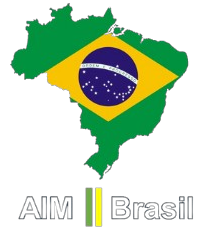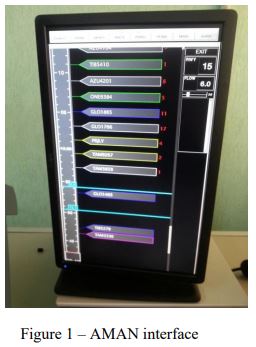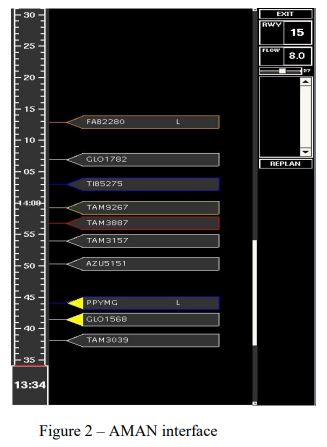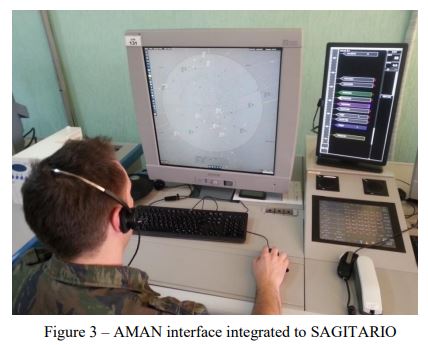This Aeronautical Information Circular (AIC) has the purpose of publicizing the implementation of the Arrival Management System (Arrival Manager – AMAN) deployed at APP-RJ.
The dispositions prescribed by this IAC apply to all SISCEAB users involved in instrument arrival operations at TMA-RJ, for SBRJ and SBGL aerodromes.
ACC-CW Area Control Center-Curitiba
AMAN* Arrival Manager
APP-RJ Approach Control-Rio de Janeiro
ATC Air Traffic Control ATCO Air Traffic Controller
CDM Collaborative Decision-Making
CGNA Air Navigation Management Center
FIR-CW Flight Information Region-Curitiba
FLOW* Longitudinal Separation in the final approach inserted in AMAN
MCA Air Force Command Manual
MFix* Metering Fix RWY Runway in use
SAGITARIO Advanced System of Air Traffic Information Management and Operational Interest Report
STAR Terminal Area Standard Arrivals
TMA Terminal Control Area
TTG* Time to Gain
TTL* Time to Lose (*) Abbreviations used in the AMAN context.
AMAN* Arrival Manager
APP-RJ Approach Control-Rio de Janeiro
ATC Air Traffic Control ATCO Air Traffic Controller
CDM Collaborative Decision-Making
CGNA Air Navigation Management Center
FIR-CW Flight Information Region-Curitiba
FLOW* Longitudinal Separation in the final approach inserted in AMAN
MCA Air Force Command Manual
MFix* Metering Fix RWY Runway in use
SAGITARIO Advanced System of Air Traffic Information Management and Operational Interest Report
STAR Terminal Area Standard Arrivals
TMA Terminal Control Area
TTG* Time to Gain
TTL* Time to Lose (*) Abbreviations used in the AMAN context.
3.1. The increase in air traffic flow at the main national Terminal Areas (TMA), as observed in recent years, indicated the need to acquire, develop and implement new tools to be used by ATC units, with the purpose of meeting this growing air traffic demand, as well as enabling the improvement of services provided for air traffic users.
3.2. DECEA acquired the Arrival Management System (Arrival Manager – AMAN), which is being used at APP-CT, APP-BH and APP-BR, and will be used at APP-RJ, as a supporting tool for collaborative decision-making (CDM) processes, for due sequencing and organization of air traffic destined to TMA-RJ, for SBRJ and SBGL aerodromes.
3.3. AMAN software is a tool which uses an adaptive planning process considering radar tracking data and flight plan data of each traffic flow, establishing a logical sequence of aircraft approach to a specific runway in use, based on longitudinal separation, in nautical miles, inserted in the system by the APP, and providing estimated times for the referred aircraft to cross MFix (to ACC) and be at the runway threshold.
3.4. The ATCO, based on estimated times provided by AMAN, may use the most suitable procedure to delay or bring forward a specific traffic flow. This new procedure will bring changes to the operational doctrine of involved units.
3.5. AMAN is a tool which requires strict compliance with calibrated parameters, according to the route structure and air navigation procedures published. The pilots’ cooperation is necessary in several situations indicated by this tool, with a view to meeting the speed restrictions of Procedure Charts, the headings for flow management and adjustments of estimated times as instructed by the ATC unit.
3.6. This tool will move the demand not absorbed by the concerned TMA for the FIR sector comprising these aerodromes, which should then abide by the restrictions enforced by MFix, enabling the TMA to be more balanced.
3.7. As described by the ones in charge of AMAN implementation at EUROCONTROL: “AMAN is not the last tool in air traffic management. It is not able to solve, nor will solve, all problems regarding arrival management, and will not replace ATCO. It is a ‘supporting tool’ and must be seen that way, and only that way. When principles and methods of operation remain ‘plain’, AMAN is efficiently used to support ATCO.” (EUROCONTROL – Arrival Manager – Implementation GUIDELINES and Lessons Learned, 2010).
Ruler with time markings where aircraft in the AMAN display are shown according to ideal estimated times for a defined point.
Reference point in which information on time adjustment is provided to ATCO at ACC-CW and at APP-SP, in a way to support aircraft sequencing planning.
Function with the purpose of withdrawing calculation traffic from the program sequencing.
Function which displays in the aircraft label that it has landing priority.
Function which adds to AMAN an aircraft not considered in the system.
Reference point in which information on time adjustment is provided to ATCO at ACC-CW and at APP-SP, in a way to support aircraft sequencing planning. It refers to the last position in sequencing, generally the threshold of the RWY in use.
5.1.1. Providing automated assistance in the arrival flow management, within a specific airspace, for specific points (runway thresholds or measuring points).
5.2.1. Establishing a logical sequence based on factor TIME for landing at SBRJ and SBGL aerodromes, informing necessary changes to estimated times for MFix (ACC-CW or APP-SP) or Feeder (APP-RJ).
NOTE: AMAN does not have the purpose of separating traffic flows or even assisting in the provision of this separation, since this is the ATCO’s responsibility.
NOTE: AMAN does not have the purpose of separating traffic flows or even assisting in the provision of this separation, since this is the ATCO’s responsibility.
5.2.2. Assisting ATCO in the optimization of RWY use, management and measuring of entry flow into the TMA.
5.2.3. Providing predictability to ATC units and users.
5.2.4. Minimizing environmental impact, avoiding holdings and vectoring at low altitudes.
5.2.5. Assisting CGNA in the adoption of flow management measures. The AMAN tool introduces a new concept of traffic sequencing and must be harmonized with the ATFM doctrine used by CGNA.
5.3.1. At APP-RJ, there is a display “Feeder-RJ” and a display “Feeder-GL”. AMAN calculates the planned schedule for each aircraft to reach the “Feeder” and positions the tags in the Time Scale (ruler), according to these schedules.
5.3.2. ATCO receives the information on aircraft delay and, by using ATC measures, such as reduction of speeds, vectorings, holdings, among others, executes the best sequencing possible.
5.4.1. At ACC-CW and APP-SP, there is a display for each MFix. The MFix used as reference points in the sequencing of traffic destined to SBGL and SBRJ are: RJ707, ROPAS, VUREP, ESORU, TOKIM, IVREV, DOKTO and ADA. AMAN calculates the planned schedule for each aircraft to reach the Metering Fix and positions the tags in the Time Scale (ruler), according to these schedules.
5.4.2. ATCO receives the information on aircraft delay and, by using ATC measures, such as reduction of speeds, vectorings, holdings, among others, executes the best sequencing possible.
a) complying with procedures described in this AIC;
b) complying with resolutions contained in the Operational Manual of the unit and the Operational Agreement Letter among APP-RJ, APP-SP and ACCCW.
b) complying with resolutions contained in the Operational Manual of the unit and the Operational Agreement Letter among APP-RJ, APP-SP and ACCCW.
a) being familiarized with procedures described in this AIC;
b) cooperating to comply with speed restrictions of Procedure Charts, headings for flow management, and adjustments of estimated times as instructed by the ATC unit.
b) cooperating to comply with speed restrictions of Procedure Charts, headings for flow management, and adjustments of estimated times as instructed by the ATC unit.
The cases not foreseen in this Circular shall be settled by the Head of Operations Subdepartment at the Department of Airspace Control.
8.2. This AIC republishes AIC A04/19.



